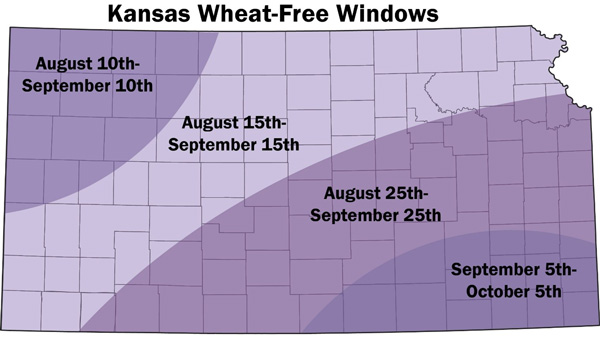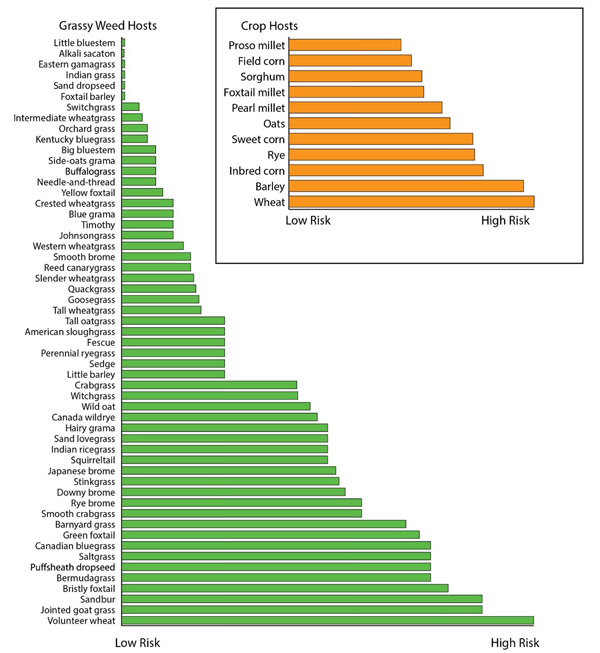This article is the second in a multi-week Agronomy eUpdate series on wheat streak mosaic complex management to address the 2025 outbreak. Last week, we revisited herbicide recommendations for volunteer wheat, and this week, we address the role of other crops in the landscape.
- Week 1: Wheat-free windows and herbicide recommendations https://bit.ly/4eSVKgP
- This week: The role of alternative host crops in the complex
Overview
Wheat streak mosaic complex devastated many wheat fields across central and western Kansas in 2025. The conditions that favored this outbreak were covered in this previous eUpdate article: (https://bit.ly/3SwJ7gU). As a reminder, wheat streak mosaic is a complex of three viruses: wheat streak mosaic virus, Triticum mosaic virus, and High Plains wheat mosaic virus. The wheat streak mosaic complex of viruses is vectored by the tiny wheat curl mite (Aceira tosichella). The highest risk place for curl mites to survive the summer is volunteer wheat. Conditions that favor grain shattering, such as preharvest hail or harvest delays due to windy storms (such as much of the 2025 Kansas wheat harvest), can increase the presence of pre-harvest volunteer wheat. If mites are allowed to survive on this volunteer wheat or alternative hosts until the fall-established wheat crop is planted, there is a high likelihood of another outbreak in 2026.
While keeping volunteer wheat controlled all summer is ideal to reduce wheat curl mite populations, it is not always practical, depending on the dynamics of rainfall and consequent wheat emergence. If it is not possible to control volunteers all summer long, there are two critical periods for volunteer control: immediately after harvest and prior to fall planting. Volunteer wheat that is present at harvest is the perfect place for populations of curl mites to migrate as the crop dries down. Controlling this volunteer wheat as soon as possible will help dilute the mite populations heading into the remaining summer months. The second critical window is pre-planting, as mites present at this time will migrate directly to the 2026 crop.
In last week’s article, we shared the recommendation for wheat-free windows (Figure 1). These windows include periods 30 days prior to the start of the optimal winter wheat planting window by zone in Kansas. As the wheat curl mite is a community pest, coordinated breaks in volunteer wheat and other cereals will have the highest likelihood of lowering local and statewide mite levels moving into our 2025 optimal winter wheat planting date periods. Volunteer wheat that emerges after the fall crop is already established poses a lower risk as a green bridge and can be thought of in a similar way as the fall crop. Fall wheat planted early, during wheat-free windows, risks bridging wheat curl mite to the fall-established crop.

Figure 1. Proposed wheat-free windows in different regions of Kansas to reduce the likelihood of a wheat streak mosaic complex outbreak during the subsequent season. Wheat-free windows are defined as the 30-day period prior to the start of the optimal winter wheat planting date for the region.
Here are some important considerations for achieving success with wheat-free windows:
- All volunteer wheat should be terminated and completely dead prior to the start of your regional wheat-free window.
- Where possible, the fall wheat crop should not be planted until the end of the wheat-free window.
- Other winter cereals (such as rye and triticale) should not be planted during this period as they can serve as a “bridge” for the curl mites to move to fall-established wheat.
- A regional “break” in the volunteer wheat green bridge will allow for wheat curl mites to die off prior to the start of the optimal wheat planting window.
- Volunteer wheat that emerges after this period is of less concern, as it will emerge at a similar time as the fall-established winter wheat crop.
- Success is dependent on coordinated efforts in communities.
Revisiting the role of other crops and weeds in the landscape
The question about the role of alternative crops and grasses in the landscape is frequently raised. The general risk of species as reservoirs for the mite and virus complex depends on several factors, including:
- How well the curl mite reproduces on a given host,
- How susceptible the host is to the virus,
- The presence of the host during critical periods over the summer,
- How those periods overlap with the wheat crop, and
- How much of the host is present in the landscape during those critical summer months (host density)?
That information was taken together to develop the relative risk of host species to harbor wheat curl mites over the summer (Figure 2). You’ll notice that the list includes cereal crops, weeds, and pasture grasses. In all, over 90 species have been shown to harbor the mites or virus to some level. Legumes are not known hosts for the curl mite or viruses.
Volunteer wheat left over the summer is the highest risk host because it checks all the boxes for risk. The curl mites will reproduce rapidly on volunteer wheat, it is usually present right after harvest, may be left through fall planting, it is susceptible to the viruses, and it can build to high levels in the landscape. This is why the first line of defense against wheat streak will always be volunteer wheat management (ideally during wheat-free windows – Figure 1).
Volunteer wheat can also “hide” in summer crops planted after wheat harvest as well as cover crops, complicating the ability to determine the risk of other crops in the landscape. For example, if wheat that is harvested in June and grain sorghum (or corn and soybean) is planted into that same field after wheat harvest, secondary flushes of volunteer wheat will be difficult to control.

Figure 2. From K-State Research and Extension Publication MF3383: Wheat Streak Mosaic. These graphs show the relative risk of various crops, grassy weeds, and pasture grasses to serve as hosts for the wheat streak mosaic virus and the wheat curl mite.
Winter cereals planted early (during the wheat-free windows) for grazing or cover cropping may pose a risk for harboring curl mites. Species like barley, oats, rye, and triticale have all been shown to host both the mites and the virus at fairly high levels. When at all possible, early planting of these crops near fields that will be established with a fall wheat crop should be avoided. Including these crops in a summer cover crop mix can also be risky for bridging the curl mites and viruses to the fall wheat crop.
To a lesser extent, corn and sorghum can also host the mite and virus complex. These crops are generally considered of low concern for epidemics in Kansas. Most of the research that we’ve reviewed has demonstrated that these crops are most conducive to curl mite survival during early growth stages. So, for example, corn/sorghum at a young stage when wheat is drying down would be at higher risk for curl mites than late-planted corn. It appears that curl mites are limited to corn husks later in the season and can result in symptoms of kernel red streak through feeding damage. Kernel red streak is generally considered a cosmetic issue in corn, but can serve as a sign that curl mites were present. Most commercial corn hybrids are resistant to wheat streak mosaic virus and High Plains wheat mosaic virus and will not experience yield losses to those viruses. Importantly, it appears that curl mite populations rapidly decline in the corn crop after the crop reaches black layer.
Weedy grass hosts (detailed in Figure 2) are generally a lower concern, unless they are allowed to build to high levels and remain established through the summer months. Their role in epidemics is dictated by their abundance and the time they are allowed to persist in the landscape.
Kelsey Andersen Onofre, Extension Wheat Pathologist
andresenk@ksu.edu
Sarah Lancaster, Extension Weed Science Specialist
slancaster@ksu.edu
Anthony Zukoff, Extension Entomology
azukoff@ksu.edu
Romulo Lollato, Extension Wheat and Forages Specialist
lollato@ksu.edu
Jeanne Falk Jones, Multi-County Agronomist
jfalkjones@ksu.edu
Tags: volunteer wheat wheat streak mosaic wheat curl mite green bridge